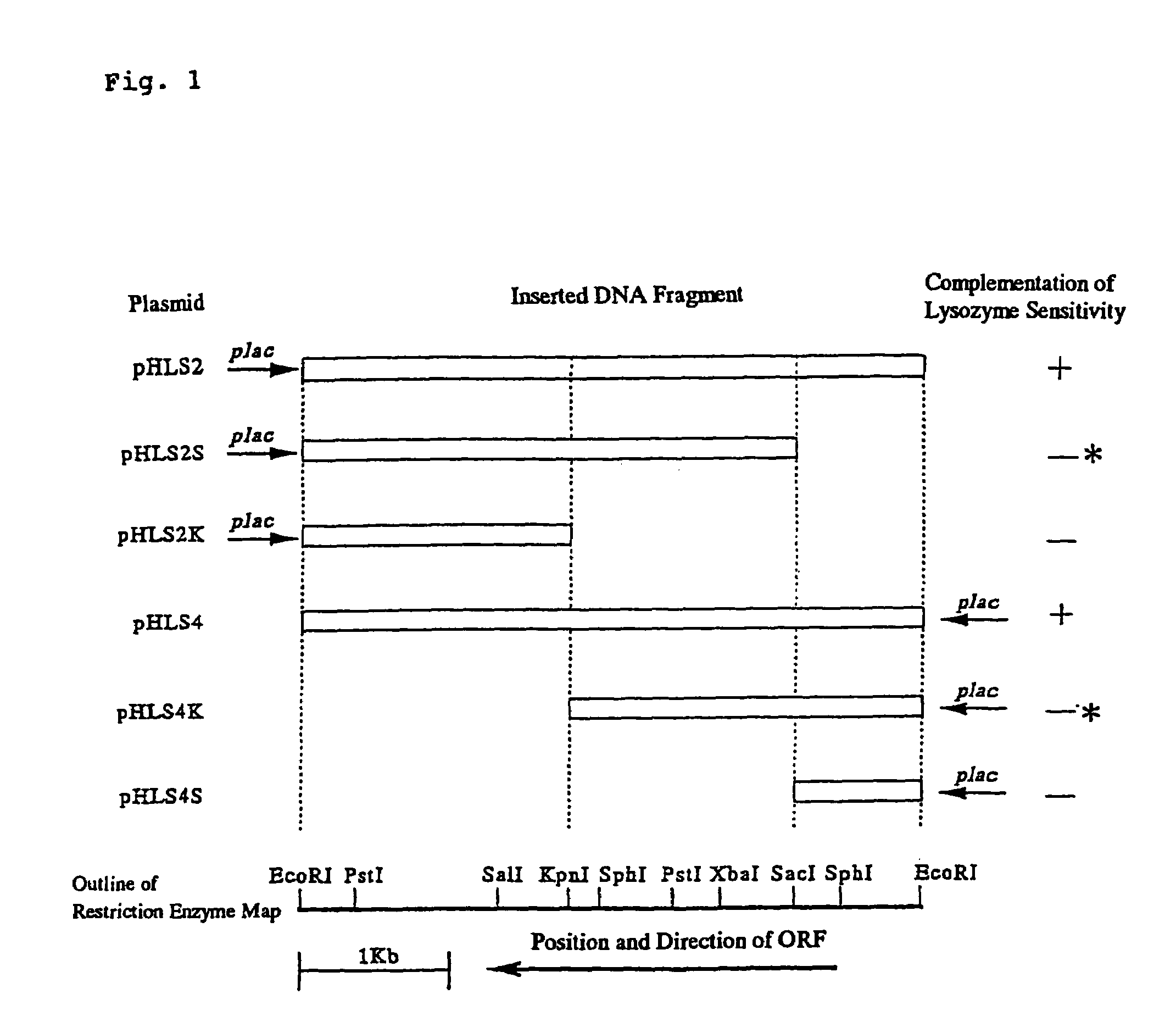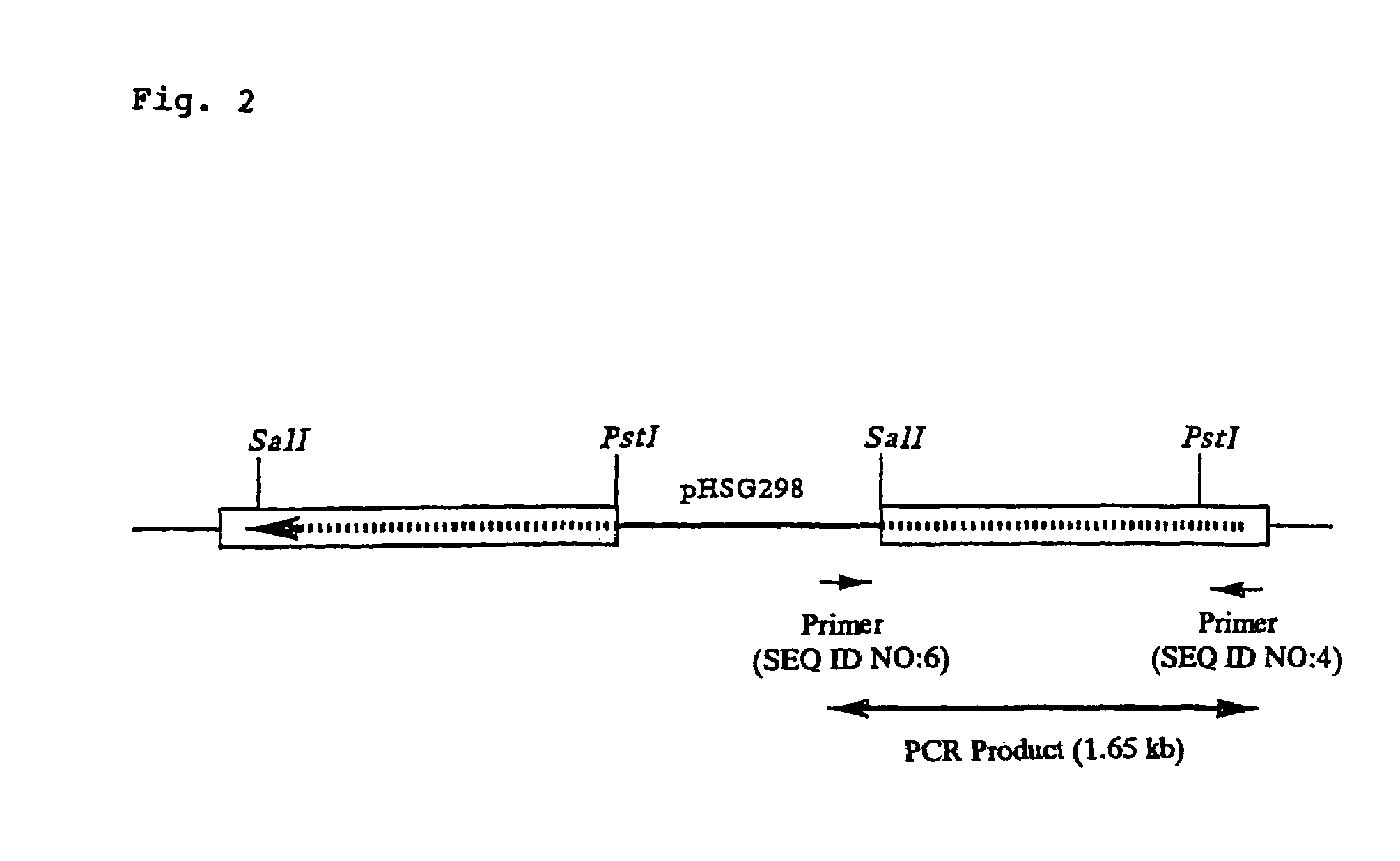Gene conferring lysozyme insensitivity to Corynebacterium
a technology of lysozyme and corynebacterium, which is applied in the field of gene conferring lysozyme insensitivity to corynebacterium, can solve the problems of difficult to obtain a desired lysozyme-sensitive microorganism efficiently, and achieve the effect of increasing the production amount of protein
- Summary
- Abstract
- Description
- Claims
- Application Information
AI Technical Summary
Benefits of technology
Problems solved by technology
Method used
Image
Examples
example 1
Preparation of Chromosomal DNA of Corynebacterium Glutamicum KY9611 Strain
[0144]Corynebacterium glutamicum KY9611 strain was inoculated on 10 ml of L′ medium (1% polypeptone, 0.5% yeast extract, 0.5% sodium chloride, 0.1% glucose, and 20 μg / ml thiamine; pH 7.2) and cultured overnight at 30° C.
[0145]After the culturing, cells were collected from the resulting culture by centrifugation.
[0146]The cells were washed with TE buffer [50 mM Tris-HCl and 50 mM ethylenediaminetetraacetic acid (EDTA); pH 8.0] and suspended in 800 μl of the same buffer. To the suspension, 40 μl of 50 mg / ml lysozyme solution and 20 μl of 10 mg / ml RNase A solution were added, and the reaction was carried out at 37° C. for 1 hour. To the reaction solution, 20 μl of 20% sodium dodecylsulfate (SDS) solution was added, and the reaction was carried out at 70° C. for 1 hour. Proteinase K solution (20 mg / ml, 24 μl) was added, and the reaction was carried out at 50° C. for 1 hour. Further, 24 μl of the proteinase K solut...
example 2
Preparation of Gene Recovering Lysozyme Sensitivity
[0147]The chromosomal DNA (0.5 μg) obtained in Example 1 and 0.5 μg of plasmid pC2 were cleaved with EcoRI and subjected to a ligation reaction using a ligation kit (TaKaRa DNA Ligation Kit Ver.2 manufactured by Takara Shuzo) at 16° C. for 16 hours.
[0148]Corynebacterium glutamicum KY9714 strain was transformed using the ligation reaction solution according to the method described in Molecular Cloning Second Edition, and a transformant was selected utilizing temperature-sensitive growth of KY9714 strain. Specifically, the transformant was spread onto L′ agar plate medium (prepared by adding 1.5% of agar to L′ medium) containing 5 μl / ml kanamycin and cultivated at 37° C. for three days.
[0149]All of the resulting colonies showed a good growth on L′ agar plate medium containing 100 μg / ml lysozyme, indicating that they were insensitive to lysozyme. The resulting colonies were cultured by the method described in Example 1, and the plasmid...
example 3
Identification of Mutation Point of Lysozyme-Sensitive Strain
[0155]A chromosomal DNA of Corynebacterium glutamicum KY9714 strain was prepared by the same method as in Example 1. Based upon a finding that the SacI-KpnI fragment of about 1.2 kb of Example 2 includes a mutation causative of lysozyme sensitivity of Corynebacterium glutamicum KY9714 strain, PCR was carried out using a chromosomal DNA of KY9714 strain as a template and using the DNA described in SEQ ID NO: 6, corresponding to the 70th to 77th amino acid residues from the N-terminus of the ORF of 1920 bp, and the DNA described in SEQ ID NO: 5, corresponding to the 335th to 342nd amino acid residues from the N-terminus of the same, as primers.
[0156]The PCR was carried out using TaKaRa LA PCR Kit Ver. 2.2 for 29 cycles where one cycle contains the reaction steps of 94° C. for one minute, 98° C. for 20 seconds, 50° C. for 30 seconds, and 62° C. for 3 minutes, and then the reaction was further carried out at 70° C. for 10 minu...
PUM
| Property | Measurement | Unit |
|---|---|---|
| concentration | aaaaa | aaaaa |
| temperature | aaaaa | aaaaa |
| temperature | aaaaa | aaaaa |
Abstract
Description
Claims
Application Information
 Login to View More
Login to View More - R&D
- Intellectual Property
- Life Sciences
- Materials
- Tech Scout
- Unparalleled Data Quality
- Higher Quality Content
- 60% Fewer Hallucinations
Browse by: Latest US Patents, China's latest patents, Technical Efficacy Thesaurus, Application Domain, Technology Topic, Popular Technical Reports.
© 2025 PatSnap. All rights reserved.Legal|Privacy policy|Modern Slavery Act Transparency Statement|Sitemap|About US| Contact US: help@patsnap.com


